在 Matplotlib 条形图上添加值标签
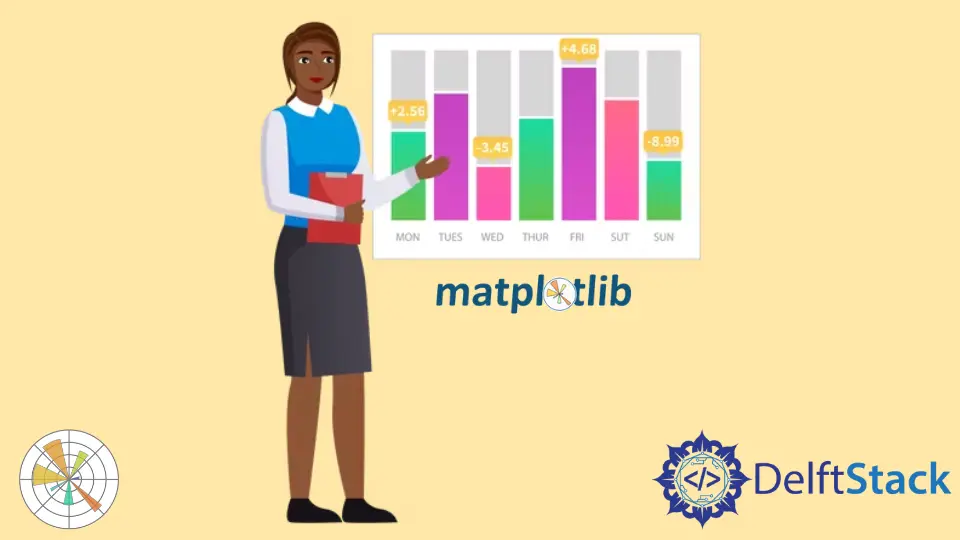
Matplotlib 条形图是在 Python 中可视化数据的好方法。在条形图中,我们经常需要添加标签来可视化数据。本文将介绍在 Matplotlib 条形图上添加值标签的各种方法。
使用 pyplot.text() 方法在 Matplotlib 条形图上添加值标签
要在 Matplotlib 条形图上添加值标签,我们可以使用 pyplot.text() 函数。
Matplotlib 模块中的 pyplot.text() 函数用于将文本值添加到图中的任何位置。pyplot.text() 函数的语法如下。
matplotlib.pyplot.text(x, y, s, fontdict=None, **kwargs)
这里,
- 参数
x和y是放置文本的图形坐标。参数s包含文本字符串。 - 参数
fontdict用于更改文本的字体和大小等属性。它的默认值是None。 **kwargs参数表示用于确定条形图中文本位置的其他参数。
在本文中,我们将使用参数 ha 来决定文本的水平对齐方式。你可以从 text() 函数的官方文档 中更深入地了解该函数的其他参数。
现在让我们绘制一个条形图,然后为其添加值标签。假设我们有一所学校从班级 1 到班级 10 的一个班级的学生人数数据以列表的形式如下。
no_of_students = [10, 24, 45, 30, 23, 56, 67, 34, 45, 50]
这里,索引 i 代表班级 i+1 的学生人数。为了绘制数据,我们将创建一个列表 class_number,其中包含从 1 到 10 的数字。之后,我们将使用 pyplot.bar() 函数绘制条形图。然后,我们将分别使用 title()、xlabel() 和 ylabel() 函数将 title、xlabel 和 ylabel 添加到图中。
为了添加值标签,我们将定义一个函数 add_value_label(x_list,y_list)。这里,x_list 和 y_list 是包含 x 轴和 y 轴数据的列表,即 class_number 和 no_of_students。
在函数 add_value_label() 中,我们将值标签的坐标指定为 (x, the height of the bar chart at x),以便将值标签添加到条形图的顶部。传递给 text 函数的文本值将是条形图在 x 处的高度。此处,x 将是 class_number 的元素,而 the height of bar chart at x 将是班级 x 中相应的学生人数。
例如,我们将每个班级的学生人数作为值标签添加到条形图的顶部。
import matplotlib.pyplot as plt
def add_value_label(x_list, y_list):
for i in range(1, len(x_list) + 1):
plt.text(i, y_list[i - 1], y_list[i - 1])
no_of_students = [10, 24, 45, 30, 23, 56, 67, 34, 45, 50]
class_number = [1, 2, 3, 4, 5, 6, 7, 8, 9, 10]
plt.bar(class_number, no_of_students)
add_value_label(class_number, no_of_students)
plt.title("No of Students in a class")
plt.xlabel("Class")
plt.ylabel("Number of Students")
plt.show()
输出:
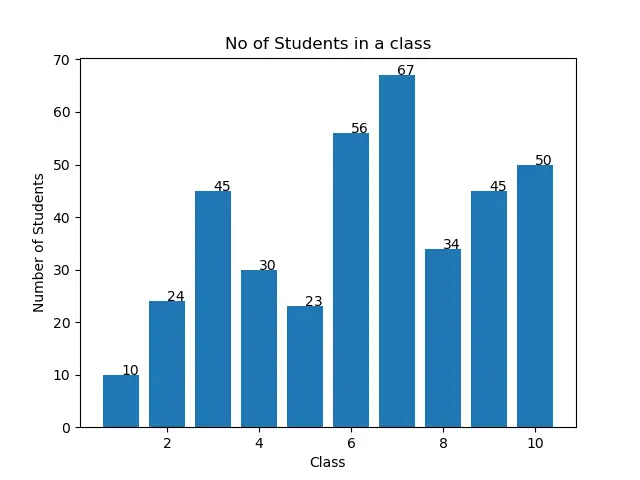
你可能会观察到值标签不在输出条形图顶部的中心。我们可以通过操作输入参数来做到这一点,如以下部分所述。
在每个条形图的中心在 Matplotlib 条形图上添加值标签
要在条形图顶部中心的 Matplotlib 条形图上添加值标签,我们将在 pyplot.text() 函数中指定水平对齐方式为 center,如下所示。
import matplotlib.pyplot as plt
def add_value_label(x_list, y_list):
for i in range(1, len(x_list) + 1):
plt.text(i, y_list[i - 1], y_list[i - 1], ha="center")
no_of_students = [10, 24, 45, 30, 23, 56, 67, 34, 45, 50]
class_number = [1, 2, 3, 4, 5, 6, 7, 8, 9, 10]
plt.bar(class_number, no_of_students)
add_value_label(class_number, no_of_students)
plt.title("No of Students in a class")
plt.xlabel("Class")
plt.ylabel("Number of Students")
plt.show()
输出:
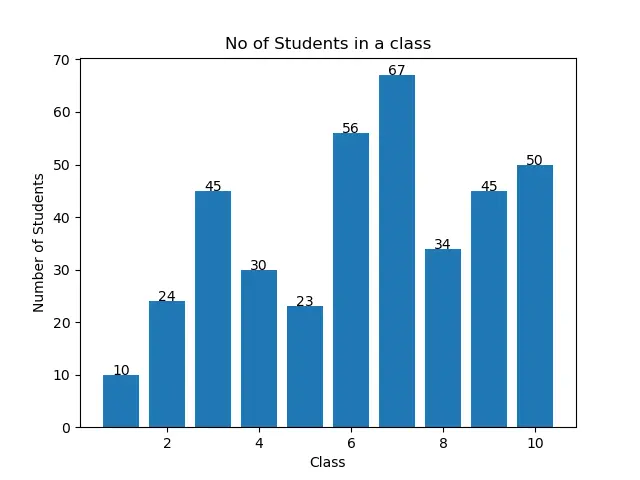
在每个条形高度中间的 Matplotlib 条形图上添加值标签
你还可以在每个条形高度的中间添加值标签。为此,我们必须在 pyplot.text() 函数中将 y 坐标指定为 (x 处条形图的高度)/2。你可以在以下示例代码中看到这一点。
import matplotlib.pyplot as plt
def add_value_label(x_list, y_list):
for i in range(1, len(x_list) + 1):
plt.text(i, y_list[i - 1] / 2, y_list[i - 1], ha="center")
no_of_students = [10, 24, 45, 30, 23, 56, 67, 34, 45, 50]
class_number = [1, 2, 3, 4, 5, 6, 7, 8, 9, 10]
plt.bar(class_number, no_of_students)
add_value_label(class_number, no_of_students)
plt.title("No of Students in a class")
plt.xlabel("Class")
plt.ylabel("Number of Students")
plt.show()
输出:
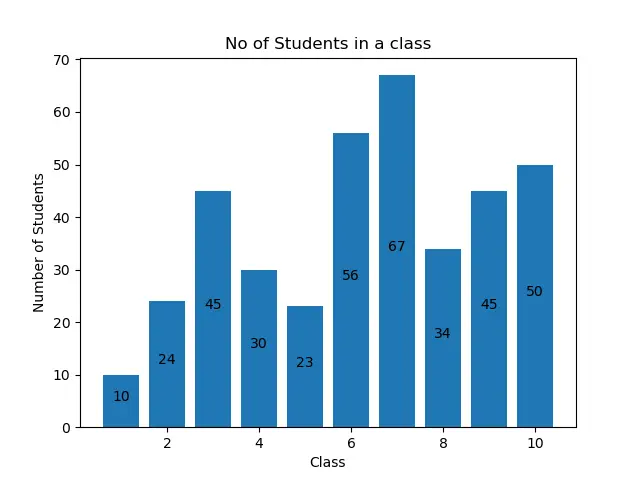
使用 pyplot.annotate() 函数在 Matplotlib 条形图上添加值标签
除了 pyplot.text() 函数,我们可以使用 pyplot.annotate() 函数在 matplotlib 条形图上添加值标签。pyplot.annotate() 函数的语法如下。
matplotlib.pyplot.annotate(text, xy, *args, **kwargs)
这里,
- 参数
text是将添加到图表中的标签。 - 参数
xy接受一个元组(x,y),其中x和y是将标签添加到图形的坐标。 - 该函数接受许多不同的参数。本文将仅使用参数
ha来设置条形图中标签的水平对齐方式。
我们将使用 pyplot.bar() 函数绘制条形图。然后,我们将分别使用 title()、xlabel() 和 ylabel() 函数将 title、xlablel 和 ylabel 添加到图中。
为了在 Matplotlib 条形图上添加值标签,我们将定义一个函数 add_value_label(x_list,y_list)。这里,x 和 y 是包含 x 轴和 y 轴数据的列表。在函数 add_value_label() 中,我们将根据为 x 和 y 坐标提供的数据创建的元组作为输入参数传递给参数 xy。有了这个,我们将其他值传递给 annotate() 函数,以在 Matplotlib 条形图上添加值标签,如下所示。
import matplotlib.pyplot as plt
def add_value_label(x_list, y_list):
for i in range(1, len(x_list) + 1):
plt.annotate(y_list[i - 1], (i, y_list[i - 1]))
no_of_students = [10, 24, 45, 30, 23, 56, 67, 34, 45, 50]
class_number = [1, 2, 3, 4, 5, 6, 7, 8, 9, 10]
plt.bar(class_number, no_of_students)
add_value_label(class_number, no_of_students)
plt.title("No of Students in a class")
plt.xlabel("Class")
plt.ylabel("Number of Students")
plt.show()
输出:
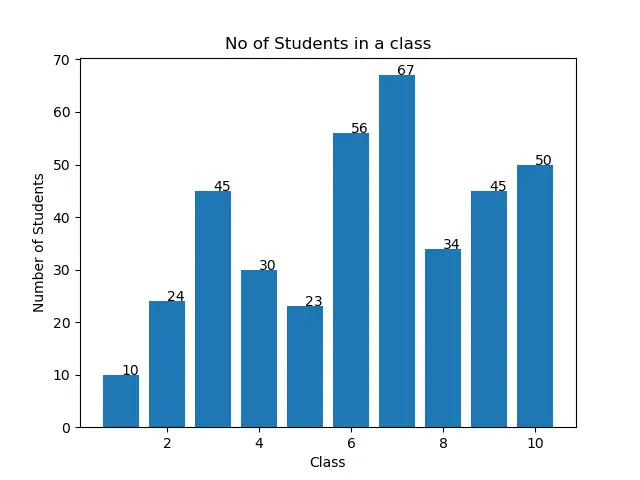
同样,你可以观察到标签未与条形图对齐。要对齐它们,你可以使用水平对齐参数 ha 设置以下对齐方式。
import matplotlib.pyplot as plt
def add_value_label(x_list, y_list):
for i in range(1, len(x_list) + 1):
plt.annotate(y_list[i - 1], (i, y_list[i - 1]), ha="center")
no_of_students = [10, 24, 45, 30, 23, 56, 67, 34, 45, 50]
class_number = [1, 2, 3, 4, 5, 6, 7, 8, 9, 10]
plt.bar(class_number, no_of_students)
add_value_label(class_number, no_of_students)
plt.title("No of Students in a class")
plt.xlabel("Class")
plt.ylabel("Number of Students")
plt.show()
输出:
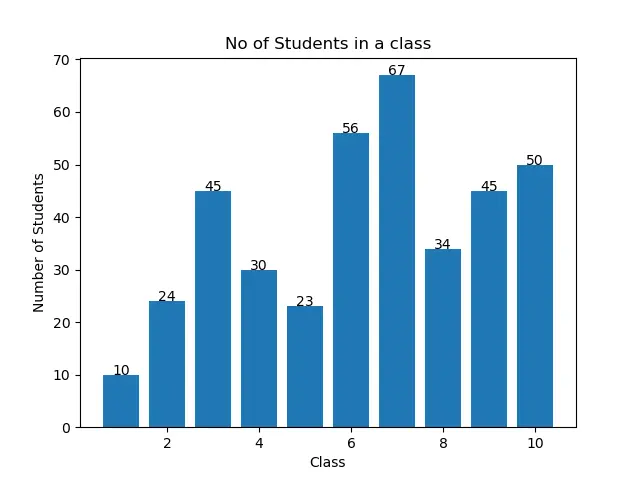
你还可以在每个条形高度的中间添加值标签。为此,我们必须将元组中的 y 坐标指定为 (x 处条形图的高度)/2。你可以在以下示例代码中看到这一点。
import matplotlib.pyplot as plt
def add_value_label(x_list, y_list):
for i in range(1, len(x_list) + 1):
plt.annotate(y_list[i - 1], (i, y_list[i - 1] / 2), ha="center")
no_of_students = [10, 24, 45, 30, 23, 56, 67, 34, 45, 50]
class_number = [1, 2, 3, 4, 5, 6, 7, 8, 9, 10]
plt.bar(class_number, no_of_students)
add_value_label(class_number, no_of_students)
plt.title("No of Students in a class")
plt.xlabel("Class")
plt.ylabel("Number of Students")
plt.show()
输出:
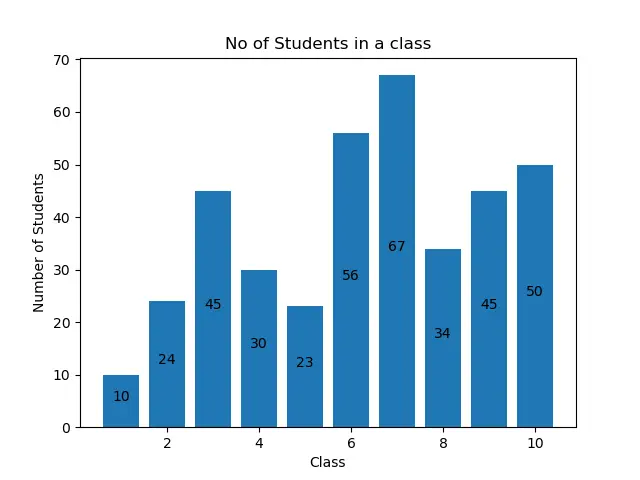
结论
本文讨论了使用 text() 函数和 annotate() 函数在 Matplotlib 条形图上添加值标签的两种方法。我们还看到了如何通过更改参数来决定标签的对齐方式和位置。你可以根据自己的方便使用任何讨论过的方法在 Matplotlib 条形图上添加值标签。